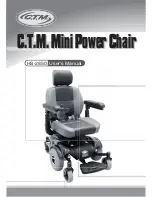
______________________________________________________________________________________________
Issue_H November 2013 19 Dash Life
13. LOOKING AFTER YOUR WHEELCHAIR - GENERAL CARE AND MAINTENANCE
READ ALL INFORMATION PROVIDED BEFORE ATTEMPTING TO USE
Users should not attempt major repairs or modifications. Approved Distributors have full Service Information
and are able to advise if the chair becomes damaged, requiring major part replacement, or refitting. If in any
doubt about service requirements, contact the Approved Distributor. The R Healthcare Customer Services
Dept is also available for more information The Service Record included with this Information Guide, has
details of model references to be quoted when Service Information is requested.
Frequency of distributor service maintenance depends on usage level. We recommend that chairs are
checked by the distributor at assessed intervals, according to the level of use and usage environment.
Warranty can be affected if a wheelchair is not adequately maintained.
Users should note that wheelchairs retain appearance if looked after and cleaned regularly, referring to the
list below for routine maintenance and safety checks, which they are responsible for.
Information received from upholstery manufacturer
The fabric used for wheelchair upholstery is easily cleaned in-situ. However, as there are some substances
which may affect the material, careful attention to REGULAR cleaning will not only prolong its life but will
ensure that its appearance is maintained.
Resistance to stains and chemicals
The upholstery is resistant to most mild acids, alkalis and household stains. Some substances such as ball-
point pen ink, lipstick, newsprint and food colourings may be absorbed by the vinyl and cause permanent
staining. This can often be minimised by immediate cleaning with a damp, soapy cloth or sponge
Cleaning
To maintain its appearance, the fabric should be cleaned REGULARLY to remove fatty substances in soiling,
which may reduce its service life. Light soiling can be removed by adding a small amount of washing up
liquid to some warm water and then applying to the fabric with a cloth. Rinse off with clean water before
allowing to dry. If need be, a Mild solution of antiseptic can be applied to the fabric.
Do not use
Chemical bleaching materials, abrasive cleaners, wax polishes or aerosol spray polishes. The use of these
substances is likely to be harmful to PVC laminates and repeated use can result in the removal of plasticiser
from the PVC compound which will result in hardening and subsequent cracking of the material’s surface.
PRESERVATION & STORAGE
If the wheelchair can not be kept indoors, then it is recommended as a minimum consideration that the
wheelchair is stored in garage type conditions, away from wet or damp areas.
During the course of general use, the wheelchair may become wet, due to rain and such events. When
practical the wheelchair should be wiped down with a dry cloth, this is to reduce the risk of corrosion.
Where wheelchairs are stored in the back of cars and similar transportation vehicles, there are occasions
especially in hotter climatic conditions such as summer, it is advisable to cover the wheelchair with a
suitable cover. This will reduce the risk of the wheel becoming hot, having an effect on user or carer
handling the chair out of the vehicle.
When a doubt exists, where the wheelchair has suffered constant miss use of storage, the wheelchair
should be removed from the client, and disposed of.













































